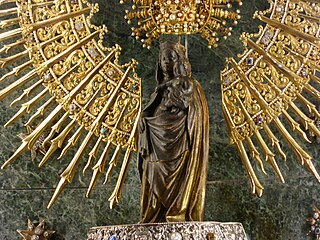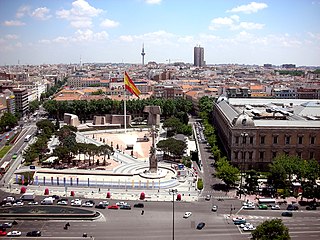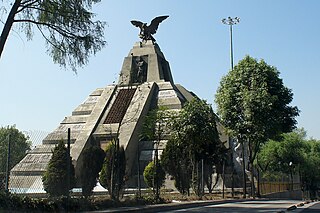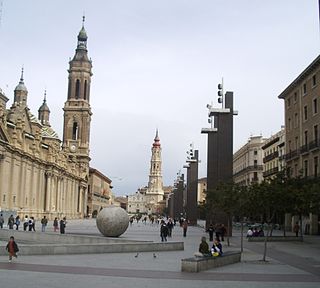
Zaragoza, also known in English as Saragossa, is the capital city of the Zaragoza Province and of the autonomous community of Aragon, Spain. It lies by the Ebro river and its tributaries, the Huerva and the Gállego, roughly in the center of both Aragon and the Ebro basin.

Columbus Day is a national holiday in many countries of the Americas and elsewhere, and a federal holiday in the United States, which officially celebrates the anniversary of Christopher Columbus's arrival in the Americas on October 12, 1492.

The National Day of Spain is the official name of the national festivity of Spain. It is held annually on 12 October and is a national holiday. It is also traditionally and commonly referred to as the Día de la Hispanidad, commemorating the Spanish legacy to the world, especially in America.

Our Lady of the Pillar is the name given to the Blessed Virgin Mary in the context of the traditional belief that Mary, while living in Jerusalem, supernaturally appeared to the Apostle James the Greater in AD 40 while he was preaching in what is now Spain. Those who adhere to this belief consider this appearance to be the only recorded instance of Mary exhibiting the mystical phenomenon of bilocation. Among Catholics, it is also considered the first Marian apparition, and unique because it happened while Mary was still living on Earth.

The Cathedral-Basilica of Our Lady of the Pillar is a Roman Catholic church in the city of Zaragoza, Aragon (Spain). The Basilica venerates Blessed Virgin Mary, under her title Our Lady of the Pillar praised as "Mother of the Hispanic Peoples" by Pope John Paul II. It is reputed to be the first church dedicated to Mary in history.

Plaza de Colón is located in the encounter of Chamberí, Centro and Salamanca districts of Madrid, Spain. This plaza and its fountain commemorate the explorer Christopher Columbus, whose name in Spanish was Cristóbal Colón.

The Macroplaza or La Gran Plaza is a town square or plaza located in the heart of the city of Monterrey, Mexico.

The Spanish expression la Raza has historically been used to refer to the Hispanophone populations, considered as an ethnic or racial unit historically deriving from the Spanish Empire, and the process of racial intermixing of the Spanish colonizers with the indigenous populations of the Americas.
Jardines del Pedregal or simply El Pedregal is an upscale residential colonia (neighborhood) in southern Mexico City hosting some of the richest families of Mexico. It is also known as the home to the biggest mansion in the city. It borders are San Jerónimo Avenue and Ciudad Universitaria at the north, Insurgentes Avenue at the east and Periférico at south and west. Its 1,250 acres (5.1 km2) were the major real estate project undertaken by Mexican modernist architect Luis Barragán.

Hispanidad is a Spanish term alluding to the group of people, countries, and communities that share the Spanish language and Hispanic culture. The term can have various, different implications and meanings depending on country of origin, socio-political views, and cultural background.

Plaza Las Delicias is the main plaza in the city of Ponce, Puerto Rico. The square is notable for its fountains and for the various monuments it contains. The historic Parque de Bombas and Ponce Cathedral buildings are located within the plaza, which actually consists of two squares: Plaza Muñoz Rivera on the north end, and Plaza Degetau on the southern end. The square is the center of the Ponce Historic Zone, and it is flanked by the historic Ponce City Hall to the south, the early 19th-century Teatro Fox Delicias to the north, the NRHP-listed Banco Crédito y Ahorro Ponceño and Banco de Ponce buildings to the east, and the Armstrong-Poventud Residence to the west. The square dates back to the early Spanish settlement in Ponce of 1670. It is the main tourist attraction of the city, receiving about a quarter of a million visitors per year.

Plaza del Emperador Carlos V is a square in the city of Madrid. It is named after Charles V, Holy Roman Emperor, who also reigned in Spain as Charles I. However, it is referred to as Plaza de Atocha, because it is where Madrid Atocha railway station is located.

Plaza Degetau, formally Plaza Federico Degetau, is the larger of two plazas at Plaza Las Delicias, the main city square in the city of Ponce, Puerto Rico. The other plaza is named Plaza Muñoz Rivera and is located north of Plaza Degetau. The square is notable for its fountains and for the various monuments it contains. The historic Parque de Bombas and Ponce Cathedral buildings are located bordering the north side of this plaza. The square is the center of the Ponce Historic Zone, and it is flanked by the historic Ponce City Hall to the south, the Cathedral and historic firehouse to the north, the NRHP-listed Banco Crédito y Ahorro Ponceño and Banco de Ponce buildings to the east, and the Armstrong-Poventud Residence to the west. The square dates back to the early Spanish settlement in Ponce of 1670. It is the main tourist attraction of the city, receiving about a quarter of a million visitors per year.

Zaragoza Comarca is a comarca in Aragon, Spain. It is located in the center of Zaragoza Province and includes Zaragoza metropolitan area.

The Parque de María Luisa is a public park that stretches along the Guadalquivir River in Seville, Spain. It is Seville's principal green area.

The Fountain of Cybele in Mexico City is a bronze replica of the fountain located in the Plaza de Cibeles in Madrid that was built during the reign of Charles III by architect Ventura Rodríguez between 1777 and 1792. The Mexican version is located at a traffic circle in Plaza Villa de Madrid, where Oaxaca, Durango, Medellín and El Oro streets converge in Colonia Roma.

The Plaza of Our Lady of the Pillar is one of the busiest popular places in Zaragoza, Spain. In it is the Cathedral-Basilica of Our Lady of the Pillar, where the homonymous Marian invocation is venerated. It's known by the nickname of "El salón de la ciudad", since many public parties are held there. 1 It is also called Plaza de las Catedrales, because it has the two cathedrals of Zaragoza: the Seo and the Pilar.

Fuente de los Cántaros is an outdoor fountain and sculpture of an indigenous woman in Mexico City's Parque México, in Mexico, created by José María Hernández Urbina in 1927, and restored in 2008.

The Monumento a la Raza is an outdoor marble monument in the city of Seville, Andalusia, Spain. It is installed along María Luisa Park. It was inaugurated on 12 October 1929—the Día de la Hispanidad. It has written part of the 1905 poem "Salutación del optimista", written by Nicaraguan poet Rubén Darío (1867–1916).

The Plaza de la Verdura is a square of medieval origin located in the heart of the historic centre of Pontevedra (Spain). It is one of the liveliest medieval squares in the city.


















